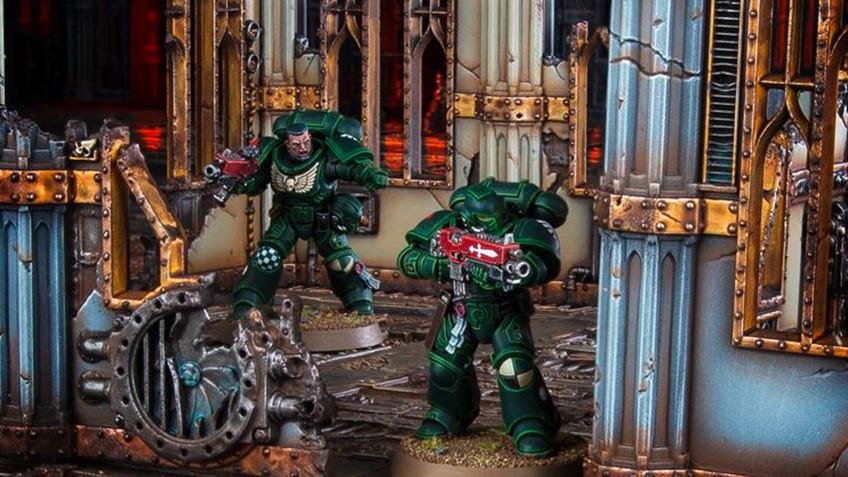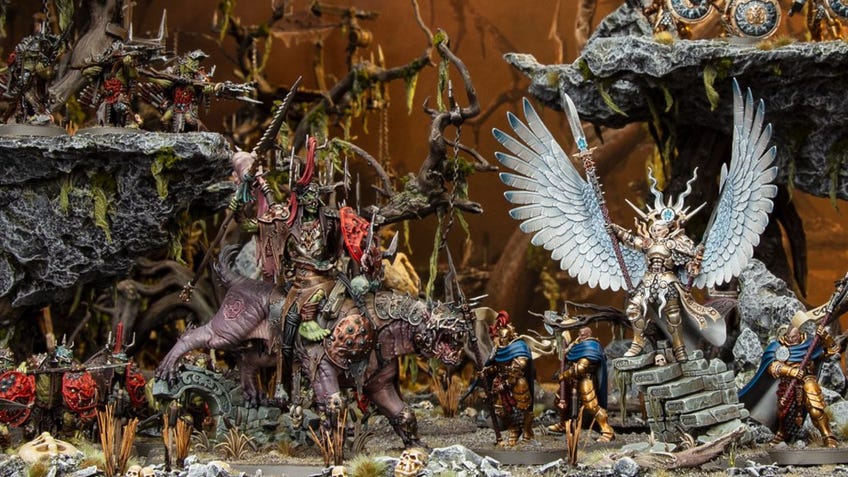What's the difference between Warhammer 40,000 and Age of Sigmar?
A beginner’s guide to Games Workshop’s flagship miniatures games.
Age of Sigmar and Warhammer 40,000 set the tone for turmoil and war, but deciding which tabletop miniatures game to play can be intimidating for a budding hobbyist. There are dozens of factions, tons of literature and a financial commitment to consider when starting on your wargaming journey.
Fortunately, both games created by Games Workshop offer something for every kind of player despite the differences between Warhammer 40k and Age of Sigmar.
Warhammer 40k and Age of Sigmar differences
- Warhammer 40k and Age of Sigmar history
- Warhammer 40k and Age of Sigmar lore explained
- Which Warhammer is most popular?
- Do Warhammer 40k and Age of Sigmar have the same rules?
- Which Warhammer is easier to learn?
- Can you use Age of Sigmar models in Warhammer 40k?
- Which Warhammer is easiest to paint and build?
- Which Warhammer is best for beginners?
When it comes to Games Workshop titles, worldbuilding is an enormous factor in deciding which tabletop game you want to play. Naturally, your preference should lie in what kind of world you want to associate with. Do you want to charge headfirst into a swarm of putrid Skaven, or do you want to be gunning down an Ork Warboss and his Nobz? Spending time figuring this out is important as there is a financial investment, and trailing back will become costly.
Warhammer 40k and Age of Sigmar history
Before sinking into the lore of both Warhammer universes, it's key to outline the origin of the two game systems. At present, the futuristic grimdark world of Warhammer 40,000 is the oldest of the two, with the first edition released back in 1987. Over the years, Warhammer 40k has gone through dozens of iterations, with various artists and writers shaping the fictional universe spanning over decades.
With Age of Sigmar, the game system is far younger and came around in 2015 following the abrupt end of Warhammer Fantasy Battles. Since Age of Sigmar is still relatively new, the high-fantasy wargame is still a work in progress, with factions and rules added frequently. There is a case that Age of Sigmar is the older of the two systems if you consider the lore and how it evolved from Warhammer Fantasy Battles. However, in terms of gameplay, Age of Sigmar is the youngest out of the two.
Warhammer 40k and Age of Sigmar lore explained
Warhammer 40k takes place at the opening of a great rift in the heart of the galaxy. The rift tore the Imperium in half, spewing out all kinds of monsters, such as Chaos, Necrons and Tyranids, to wreak havoc on the Imperium. To tackle this blight, genetically-engineered super-soldiers called Space Marines leaped in an attempt to save the Imperium from complete obliteration.
Amongst this conflict, there are the Eldar who are looking to settle a personal score with the Space Marines. Then there's the Tau, a technologically advanced race who want to expand their cause through 'peaceful' means. To summarise, everything and everyone across the galaxy is at war, one way or another.

Since the motif of Warhammer 40k is to seek victory from the jaws of Chaos, Age of Sigmar takes an opposite approach beginning with an apocalypse. The Age of Sigmar starts the day the rule of Chaos over the Mortal Realms was broken. God-King Sigmar rescued the dying souls of the heroes across the Realms, only to reforge them into his near-immortal warriors, the Stormcast Eternals. While not sounding too much like the Space Marines, the Stormcast Eternals are sent on bolts of lightning to begin reconquering the Realms from the claws of Chaos. As you can guess, there is plenty of action in Age of Sigmar - which gives you a broad selection of what is available to play despite being the younger of the two game systems.
If you want to delve further outside of the Battletomes and Codexes, Games Workshop offers a broad range of literature called the Black Library. Within the Black Library, Games Workshop publishes books regularly that focus on various factions, characters and epic battles that occur throughout the history of both wargames. Through reading the Black Library books, you can gain a deeper understanding of either Warhammer 40k or Age of Sigmar, which also lines up well for newcomers.
Which Warhammer is most popular?
In terms of popularity, Warhammer 40k is by far and away the more popular of the two systems since there are decades of lore and gameplay to support it. That’s not to say Age of Sigmar isn’t popular at all - it just needs more time to build on the successes that Warhammer Fantasy Battles brought to the table.

If you are hoping to play regularly but indifferent about the setting, visiting your local Warhammer store will give you an idea of which system is more popular locally. Since you intend to play games, you can gravitate towards the more popular system to make it worth your time and money. Competitively speaking, Warhammer 40k offers a better landscape since the rules are fairly nuanced, with Throne of Skulls previously being the headline event in the UK until the COVID-19 pandemic. Age of Sigmar competitive events do exist, but the game is geared towards accessibility and casual play rather than emphasising tournament play.
Do Warhammer 40k and Age of Sigmar have the same rules?
Both Warhammer games work in turns, rounds and phases. Rounds consist of a turn for each player, with each turn consisting of a series of phases.
The speed of games is what sets them apart, with Age of Sigmar encouraging a more compact and fast-paced experience so you can fit more games in. In comparison, Warhammer 40,000 sacrifices speed but adds a tactical layer that is missing in Age of Sigmar. Warhammer 40k offers an incredible level of simulation to combat, with various weapon types, multi-damage weapons and additional melee options available.
If you love detail and subtlety when it comes to combat, Warhammer 40,000 offers plenty whereas Age of Sigmar is catered towards casual and new players, since the rules are compact compared to its big grimdark sibling.
Which Warhammer is easier to learn?
When it comes to playing either system, the basic rules are available to download for free for both Warhammer 40k and Age of Sigmar - but they're only simple rules to get you started. You can play games with these rules, but eventually you'll need a rulebook to delve into the finer details for a complete experience.
For playing with the most up-to-date rules, Warhammer 40,000 uses the Core Rulebook, which has everything you need to get started, including a detailed introduction to the lore. If you're itching for matched play, the Chapter Approved Book contains the relevant point updates for units, with extra missions to offer a challenge on the battlefield. Going further, there are Codexes which are dedicated books to specific armies within Warhammer 40k - making them the definitive guide to that particular faction.

Similarly, Age of Sigmar uses the Age of Sigmar Core Book, which contains the complete rules for the game with supporting lore. Alongside the Core Book, there is the General's Handbook which provides updates to battleplan rules for tournament and competitive play. Like Codexes in Warhammer 40k, Age of Sigmar uses Battletomes that give a complete guide on a specific faction with rules and background information to support it.
One benefit to playing Age of Sigmar as a beginner is the digital availability of its sourcebooks since the wargame is relatively new. Whereas, with Warhammer 40,000, anything that is older than the Ninth Edition released in 2020 is only available in physical form. As such, it can become tricky to get stuck in as you have to buy the Warhammer 40k books physically, which can be offputting for some.
Can you use Age of Sigmar models in Warhammer 40k?
There is some overlap. You can use Age of Sigmar models in Warhammer 40,000 if you choose to play one of the Chaos factions, since they share the same Chaos deities in both games. However, you cannot use Warhammer 40,000 models within Age of Sigmar, as bolt guns and power armour haven't quite reached the Mortal Realms yet.

Which Warhammer is easiest to paint and build?
Not all miniature enthusiasts care about the lore or want to take a competitive approach to wargaming. More commonly, you often see hobbyists take up painting and building instead. If you lean on this side of the hobby spectrum, you can pick and choose from either Warhammer 40k or Age of Sigmar and paint a miniature you like the look of.
Games Workshop does an incredible job of making its range of paints, brushes and other tools applicable for both game systems. With this, you could slowly accumulate an army without much thought or kit-bash from either to create something truly unique as a passion project.
Age of Sigmar offers more grandeur and dynamic models out of the two, with the build quality being excellent and plenty of the models not requiring glue to assemble. As Warhammer 40k is the older system, Games Workshop is slowly updating its older models, with Black Templars being the latest Space Marine chapter to receive a rehaul and an updated Codex to complement it.
Which Warhammer is best for beginners?
If you are looking for something fresh with new factions cropping up all the time, then Age of Sigmar is a great place to start. There's an exciting backdrop, accessible rules and games tend to be shorter and more fast-paced compared to Warhammer 40,000.
If you prefer a game system that is tied to tradition with an enriched backstory developed over decades, coupled with a more complex approach to combat and building army lists, then Warhammer 40k is for you. Warhammer 40,000 offers a steeper learning curve, but the community is so big it's easy to find someone to play a game or to help you get started.
Either way, there is a lot of personality in both game systems - it boils down to whether you want to smite foes with a huge hammer or shower your enemies in bullets.



